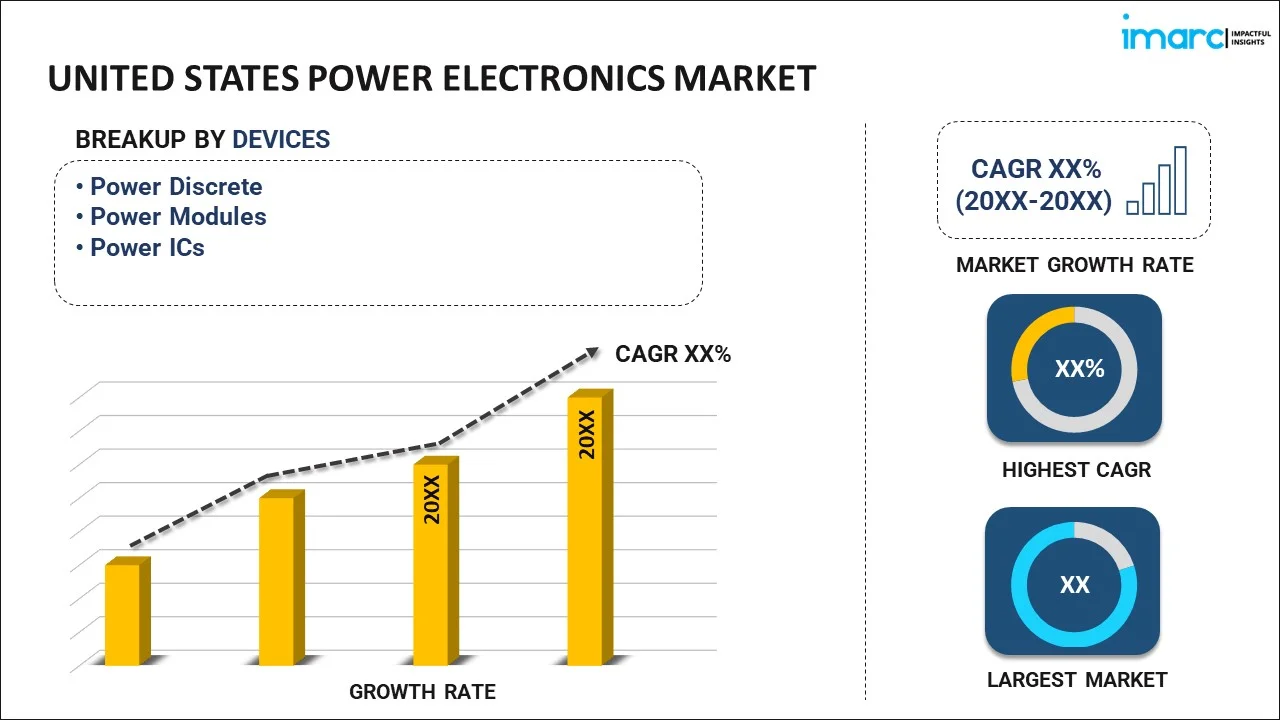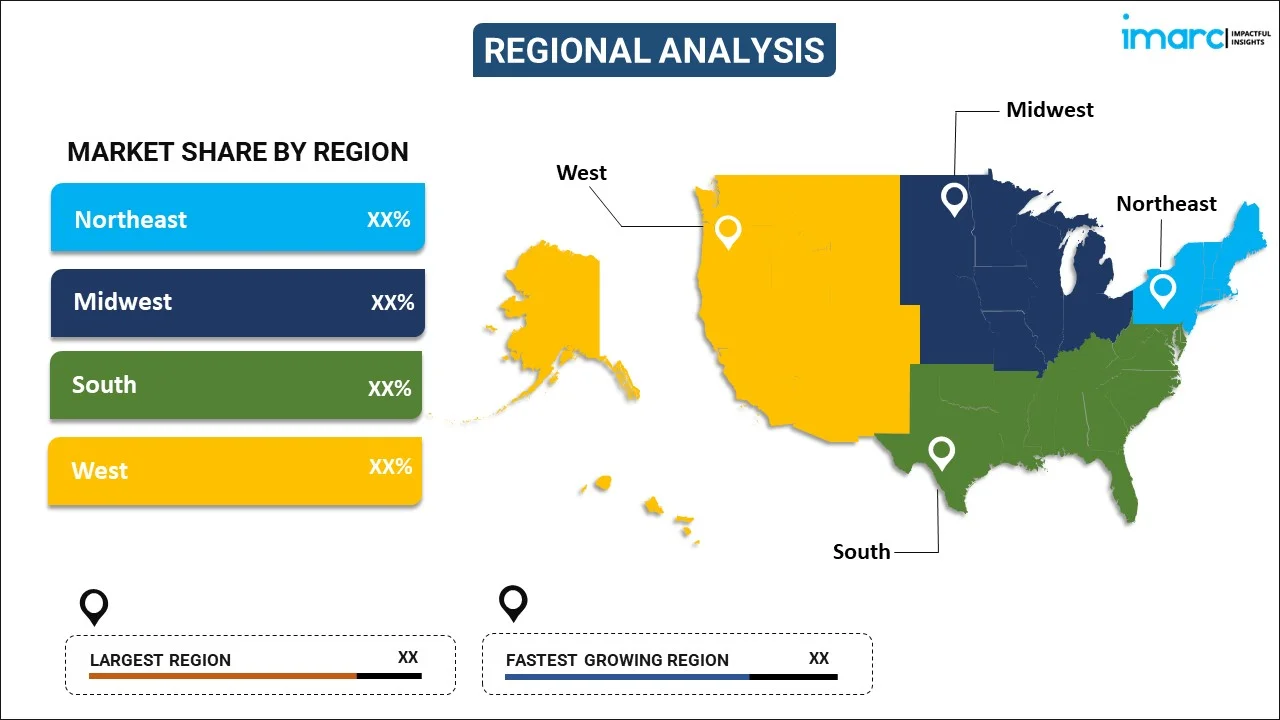
United States Power Electronics Market Report by Device (Power Discrete, Power Modules, Power ICs), Material (Silicon, Sapphire, Silicon Carbide, Gallium Nitride, and Others), Application (Power Management, UPS, Renewable, and Others), Voltage (Low Voltage, Medium Voltage, High Voltage), End Use Industry (Automotive, Military and Aerospace, Energy and Power, IT and Telecommunication, Consumer Electronics, and Others), and Region 2024-2032
Market Overview:
United States power electronics market size is projected to exhibit a growth rate (CAGR) of 7.10% during 2024-2032. The growing emphasis on energy efficiency, increasing concerns among the masses about environmental sustainability and energy conservation, and the escalating demand for data storage and processing represent some of the key factors driving the market.
|
Report Attribute
|
Key Statistics
|
|---|---|
|
Base Year
|
2023 |
|
Forecast Years
|
2024-2032
|
|
Historical Years
|
2018-2023
|
| Market Growth Rate (2024-2032) | 7.10% |
Power electronics is a branch of electrical engineering that deals with the conversion, control, and manipulation of electrical power. It involves the use of electronic devices to efficiently convert and regulate electrical energy from one form to another, making it suitable for various applications. It enhances energy efficiency by minimizing losses during energy conversion, leading to reduced energy consumption. It can improve the quality of electrical power by stabilizing voltage and frequency, reducing the risk of disruptions. It enables variable speed control in electric motors, leading to energy savings and improved performance in applications like electric vehicles and industrial machinery. It aids in integrating renewable energy sources like solar and wind into the grid, ensuring a stable power supply. It contributes to a reduced carbon footprint and environmental impact. It facilitates the conversion of direct current (DC) power generated by solar panels and wind turbines into alternating current (AC) power for grid connection. It is widely used in electric vehicle propulsion, industrial machines, and home appliances to control the speed and torque of electric motors. It is also utilized in heating, ventilation, and air conditioning (HVAC) systems for precise control of temperature and energy efficiency.
United States Power Electronics Market Trends:
The growing emphasis on energy efficiency represents one of the primary factors driving the demand for power electronics in the United States. Additionally, increasing concerns about environmental sustainability and energy conservation are encouraging industries in the United States to minimize energy wastage. Along with this, rising sales of electric vehicles (EVs) in the country are offering a favorable market outlook. Power electronics aid in controlling the flow of electricity from batteries to motors, enabling regenerative braking, and ensuring efficient energy usage. Apart from this, the escalating demand for data storage and processing is leading to the expansion of data centers and cloud computing facilities in the United States. These facilities require efficient power management systems to ensure uninterrupted operations, which is driving the demand for power electronics to provide stable and high-quality power to data centers, reducing downtime and enhancing reliability. Furthermore, the increasing adoption of automation and robotics to improve efficiency and productivity is strengthening the growth of the market. Power electronics enable precise control and regulation of electric motors and actuators in automated systems. This trend towards automation in manufacturing and logistics is driving the demand for power electronics components and systems. In line with this, several manufacturers in the United States are investing in research and development (R&D) activities to produce components and systems that can withstand harsh conditions and offer long-term reliability.
United States Power Electronics Market Segmentation:
IMARC Group provides an analysis of the key trends in each segment of the market, along with forecasts at the country level for 2024-2032. Our report has categorized the market based on device, material, application, voltage, and end use industry.
Device Insights:

- Power Discrete
- Diode
- Transistors
- Thyristor
- Power Modules
- Intelligent Power Module
- Power Integrated Module
- Power ICs
- Power Management Integrated Circuit
- Application-Specific Integrated Circuit
The report has provided a detailed breakup and analysis of the market based on the device. This includes power discrete (diode, transistors, and thyristor), power modules (intelligent power module and power integrated module), and power ICs (power management integrated circuit and application-specific integrated circuit).
Material Insights:
- Silicon
- Sapphire
- Silicon Carbide
- Gallium Nitride
- Others
A detailed breakup and analysis of the market based on the material have also been provided in the report. This includes silicon, sapphire, silicon carbide, gallium nitride, and others.
Application Insights:
- Power Management
- UPS
- Renewable
- Others
The report has provided a detailed breakup and analysis of the market based on the application. This includes power management, UPS, renewable, and others.
Voltage Insights:
- Low Voltage
- Medium Voltage
- High Voltage
A detailed breakup and analysis of the market based on the voltage have also been provided in the report. This includes low voltage, medium voltage, and high voltage.
End Use Industry Insights:
- Automotive
- Military and Aerospace
- Energy and Power
- IT and Telecommunication
- Consumer Electronics
- Others
The report has provided a detailed breakup and analysis of the market based on the end use industry. This includes automotive, military and aerospace, energy and power, IT and telecommunication, consumer electronics, and others.
Regional Insights:

- Northeast
- Midwest
- South
- West
The report has also provided a comprehensive analysis of all the major regional markets, which include Northeast, Midwest, South, and West.
Competitive Landscape:
The market research report has also provided a comprehensive analysis of the competitive landscape. Competitive analysis such as market structure, key player positioning, top winning strategies, competitive dashboard, and company evaluation quadrant has been covered in the report. Also, detailed profiles of all major companies have been provided.
United States Power Electronics Market Report Coverage:
| Report Features | Details |
|---|---|
| Base Year of the Analysis | 2023 |
| Historical Period | 2018-2023 |
| Forecast Period | 2024-2032 |
| Units | US$ Million |
| Scope of the Report | Exploration of Historical and Forecast Trends, Industry Catalysts and Challenges, Segment-Wise Historical and Predictive Market Assessment:
|
| Devices Covered |
|
| Materials Covered | Silicon, Sapphire, Silicon Carbide, Gallium Nitride, Others |
| Applications Covered | Power Management, UPS, Renewable, Others |
| Voltages Covered | Low Voltage, Medium Voltage, High Voltage |
| End Use Industries Covered | Automotive, Military and Aerospace, Energy and Power, IT and Telecommunication, Consumer Electronics, Others |
| Regions Covered | Northeast, Midwest, South, West |
| Customization Scope | 10% Free Customization |
| Report Price and Purchase Option | Single User License: US$ 3699 Five User License: US$ 4699 Corporate License: US$ 5699 |
|
Post-Sale Analyst Support |
10-12 Weeks |
| Delivery Format | PDF and Excel through Email (We can also provide the editable version of the report in PPT/Word format on special request) |
Key Questions Answered in This Report:
- How has the United States power electronics market performed so far and how will it perform in the coming years?
- What has been the impact of COVID-19 on the United States power electronics market?
- What is the breakup of the United States power electronics market on the basis of device?
- What is the breakup of the United States power electronics market on the basis of material?
- What is the breakup of the United States power electronics market on the basis of application?
- What is the breakup of the United States power electronics market on the basis of voltage?
- What is the breakup of the United States power electronics market on the basis of end use industry?
- What are the various stages in the value chain of the United States power electronics market?
- What are the key driving factors and challenges in the United States power electronics?
- What is the structure of the United States power electronics market and who are the key players?
- What is the degree of competition in the United States power electronics market?
Key Benefits for Stakeholders:
- IMARC’s industry report offers a comprehensive quantitative analysis of various market segments, historical and current market trends, market forecasts, and dynamics of the United States power electronics market from 2018-2032.
- The research report provides the latest information on the market drivers, challenges, and opportunities in the United States power electronics market.
- Porter's five forces analysis assist stakeholders in assessing the impact of new entrants, competitive rivalry, supplier power, buyer power, and the threat of substitution. It helps stakeholders to analyze the level of competition within the United States power electronics industry and its attractiveness.
- Competitive landscape allows stakeholders to understand their competitive environment and provides an insight into the current positions of key players in the market.
Need more help?
- Speak to our experienced analysts for insights on the current market scenarios.
- Include additional segments and countries to customize the report as per your requirement.
- Gain an unparalleled competitive advantage in your domain by understanding how to utilize the report and positively impacting your operations and revenue.
- For further assistance, please connect with our analysts.
 Inquire Before Buying
Inquire Before Buying
 Speak to an Analyst
Speak to an Analyst
 Request Brochure
Request Brochure
 Request Customization
Request Customization




.webp)




.webp)












